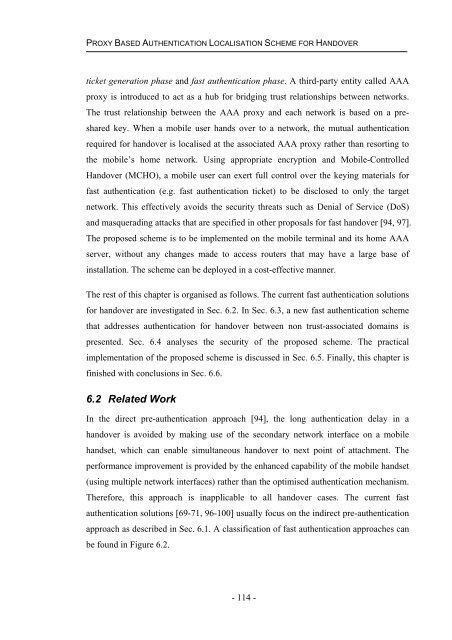Handover mechanisms in next generation heterogeneous wireless ...
Handover mechanisms in next generation heterogeneous wireless ...
Handover mechanisms in next generation heterogeneous wireless ...
Create successful ePaper yourself
Turn your PDF publications into a flip-book with our unique Google optimized e-Paper software.
PROXY BASED AUTHENTICATION LOCALISATION SCHEME FOR HANDOVER<br />
ticket <strong>generation</strong> phase and fast authentication phase. A third-party entity called AAA<br />
proxy is <strong>in</strong>troduced to act as a hub for bridg<strong>in</strong>g trust relationships between networks.<br />
The trust relationship between the AAA proxy and each network is based on a preshared<br />
key. When a mobile user hands over to a network, the mutual authentication<br />
required for handover is localised at the associated AAA proxy rather than resort<strong>in</strong>g to<br />
the mobile’s home network. Us<strong>in</strong>g appropriate encryption and Mobile-Controlled<br />
<strong>Handover</strong> (MCHO), a mobile user can exert full control over the key<strong>in</strong>g materials for<br />
fast authentication (e.g. fast authentication ticket) to be disclosed to only the target<br />
network. This effectively avoids the security threats such as Denial of Service (DoS)<br />
and masquerad<strong>in</strong>g attacks that are specified <strong>in</strong> other proposals for fast handover [94, 97].<br />
The proposed scheme is to be implemented on the mobile term<strong>in</strong>al and its home AAA<br />
server, without any changes made to access routers that may have a large base of<br />
<strong>in</strong>stallation. The scheme can be deployed <strong>in</strong> a cost-effective manner.<br />
The rest of this chapter is organised as follows. The current fast authentication solutions<br />
for handover are <strong>in</strong>vestigated <strong>in</strong> Sec. 6.2. In Sec. 6.3, a new fast authentication scheme<br />
that addresses authentication for handover between non trust-associated doma<strong>in</strong>s is<br />
presented. Sec. 6.4 analyses the security of the proposed scheme. The practical<br />
implementation of the proposed scheme is discussed <strong>in</strong> Sec. 6.5. F<strong>in</strong>ally, this chapter is<br />
f<strong>in</strong>ished with conclusions <strong>in</strong> Sec. 6.6.<br />
6.2 Related Work<br />
In the direct pre-authentication approach [94], the long authentication delay <strong>in</strong> a<br />
handover is avoided by mak<strong>in</strong>g use of the secondary network <strong>in</strong>terface on a mobile<br />
handset, which can enable simultaneous handover to <strong>next</strong> po<strong>in</strong>t of attachment. The<br />
performance improvement is provided by the enhanced capability of the mobile handset<br />
(us<strong>in</strong>g multiple network <strong>in</strong>terfaces) rather than the optimised authentication mechanism.<br />
Therefore, this approach is <strong>in</strong>applicable to all handover cases. The current fast<br />
authentication solutions [69-71, 96-100] usually focus on the <strong>in</strong>direct pre-authentication<br />
approach as described <strong>in</strong> Sec. 6.1. A classification of fast authentication approaches can<br />
be found <strong>in</strong> Figure 6.2.<br />
- 114 -












